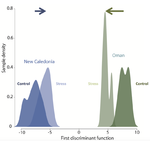
SOBRAL Mar
- ECOPAST (USC), University of Santiago de Compostela, Santiago de Compostela, Spain
- Biodiversity, Biogeography, Community ecology, Ecosystem functioning, Evolutionary ecology, Food webs, Herbivory, Interaction networks, Maternal effects, Phenotypic plasticity, Pollination, Terrestrial ecology, Theoretical ecology, Tropical ecology
- recommender
Recommendation: 1
Review: 1
Recommendation: 1

Body temperatures, life history, and skeletal morphology in the nine-banded armadillo (Dasypus novemcinctus)
Is vertebral count in mammals influenced by developmental temperature? A study with Dasypus novemcinctus
Recommended by Mar Sobral based on reviews by Darin Croft and ?Mammals show a very low level of variation in vertebral count, both among and within species, in comparison to other vertebrates [1]. Jordan’s rule for fishes states that the vertebral number among species increases with latitude, due to ambient temperatures during development [2]. Temperature has also been shown to influence vertebral count within species in fish [3], amphibians [4], and birds [5]. However, in mammals the count appears to be constrained, on the one hand, by a possible relationship between the development of the skeleton and the proliferations of cell lines with associated costs (neural malformations, cancer etc., [6]), and on the other by the cervical origin of the diaphragm [7].
Knight et al. [8] investigate the effect of intrauterine temperature variation on skeletal morphology during development, and focus on a particular mammal, Dasypus novemcinctus, or nine-banded armadillo. Armadillos (Xenarthra) and are characterized by relatively low body temperatures and low basal rates of metabolism. Dasypus novemcinctus is the only xenarthran mammal to have naturally expanded its range into the middle latitudes of the U.S., and one of the few mammals that invaded North America from South America. It is one of few placentals that withstand considerable decrease of body temperature without torpor. It presents a resting body temperature that is low and variable for a placental mammal of its size [9] and is the only vertebrate that gives birth to monozygotic quadruplets. Among 42 monotreme, marsupial and placental genera, Dasypus novemcinctus shows the highest variation of thoracolumbar vertebral count [10].
The particularities of Dasypus novemcinctus regarding vertebral count variation and ability to withstand variable temperature qualify it as a target organism for study of the relationship between skeleton morphology and temperature in mammals.
Knight et al. [8] explored variability in vertebral count within Dasypus novemcinctus to understand whether temperature during development determines skeleton morphology. To this end they experimented with 22 armadillos (19 with data) and litters from 12 pregnant females, in two environments, for three years — an impressive effort and experimental setup. Moreover, they used a wide variety of advanced experimental and analytical techniques. For example, they implanted intra-abdominal, long-term temperature recorders, which recorded data every 6 to 120 minutes for up to several months. They analysed body temperature periodicity by approximation of the recordings with Fourier series, and they CT-scanned fetuses.
All 19 individuals (from which data could be gathered) exhibited substantial daily variation in body temperature. Several intriguing results emerged such as the counter-intuitive finding that the mammals’ body temperature fluctuates more indoors than outdoors. Furthermore, three females (out of 12) were found to have offspring with atypical skeletons, and two of these mothers presented an extremely low internal temperature early in pregnancy. Additionally, genetically identical quadruplets differed skeletally among themselves within two litters.
Results are not yet definitive about the relationship of temperature during development and vertebral count in Dasypus novemcinctus. However, Knight et al. [8] demonstrated that nine-banded armadillos survive with high daily internal temperature fluctuations and successfully bring to term offspring which vary in skeletal morphology among and within genetically identical litters despite major temperature extremes.
References
[1] Hautier L, Weisbecker V, Sánchez-Villagra MR, Goswami A, Asher RJ (2010) Skeletal development in sloths and the evolution of mammalian vertebral patterning. Proceedings of the National Academy of Sciences, 107, 18903–18908. doi: 10.1073/pnas.1010335107
[2] Jordan, D.S. (1892) Relations of temperature to vertebrae among fishes. Proceedings of the United States National Museum, 1891, 107-120. doi: 10.5479/si.00963801.14-845.107
[3] Tibblin P, Berggren H, Nordahl O, Larsson P, Forsman A (2016) Causes and consequences of intra-specific variation in vertebral number. Scientific Reports, 6, 1–12. doi: 10.1038/srep26372
[4] Peabody RB, Brodie ED (1975) Effect of temperature, salinity and photoperiod on the number of trunk vertebrae in Ambystoma maculatum. Copeia, 1975, 741–746. doi: 10.2307/1443326
[5] Lindsey CC, Moodie GEE (1967) The effect of incubation temperature on vertebral count in the chicken. Canadian Journal of Zoology, 45, 891–892. doi: 10.1139/z67-099
[6] Galis F, Dooren TJMV, Feuth JD, Metz JAJ, Witkam A, Ruinard S, Steigenga MJ, Wunaendts LCD (2006) Extreme selection in humans against homeotic transformations of cervical vertebrae. Evolution, 60, 2643–2654. doi: 10.1111/j.0014-3820.2006.tb01896.x
[7] Buchholtz EA, Stepien CC (2009) Anatomical transformation in mammals: developmental origin of aberrant cervical anatomy in tree sloths. Evolution and Development, 11, 69–79. doi: 10.1111/j.1525-142X.2008.00303.x
[8] Knight F, Connor C, Venkataramanan R, Asher RJ. (2020). Body temperatures, life history, and skeletal morphology in the nine-banded armadillo (Dasypus novemcinctus). PCI-Ecology. doi: 10.17863/CAM.50971
[9] McNab BK (1980) Energetics and the limits to a temperate distribution in armadillos. Journal of Mammalogy, 61, 606–627. doi: 10.2307/1380307
[10] Asher RJ, Lin KH, Kardjilov N, Hautier L (2011) Variability and constraint in the mammalian vertebral column. Journal of Evolutionary Biology, 24, 1080–1090. doi: 10.1111/j.1420-9101.2011.02240.x
Review: 1

Gene expression plasticity and frontloading promote thermotolerance in Pocillopora corals
Transcriptomics of thermal stress response in corals
Recommended by Staffan Jacob based on reviews by Mar SobralClimate change presents a challenge to many life forms and the resulting loss of biodiversity will critically depend on the ability of organisms to timely respond to a changing environment. Shifts in ecological parameters have repeatedly been attributed to global warming, with the effectiveness of these responses varying among species [1, 2]. Organisms do not only have to face a global increase in mean temperatures, but a complex interplay with another crucial but largely understudied aspect of climate change: thermal fluctuations. Understanding the mechanisms underlying adaptation to thermal fluctuations is thus a timely and critical challenge.
Coral reefs are among the most threaten ecosystems in the context of current global changes [3]. Brener-Raffalli and colleagues [4] provided a very complete study digging into the physiological, symbiont-based and transcriptomic mechanisms underlying response of corals to temperature changes. They used an experimental approach, following the heat stress response of coral colonies from different species of the genus Pocillopora. While the symbiont community composition did not significantly change facing exposure to warmer temperatures, the authors provided evidence for transcriptomic changes especially linked to stress response genes that may underlie plastic responses to heat stress.
The authors furthermore investigated the thermal stress response of corals originating from two sites differing in their natural thermal regimes, and found that they differ in the extent and nature of plastic response, including the expression of gene regulation factors and the basal expression level of some genes. These two sites also differ in a variety of aspects, including the focal coral species, which precludes from concluding about the role of thermal regime adaptation into the differences observed. However, these results still highlight a very interesting and important direction deserving further investigation [5], and point out the importance of variability in thermal stress response among localities [6] that might potentially mediate global warming consequences on coral reefs.
References
[1] Parmesan, C., & Yohe, G. (2003). A globally coherent fingerprint of climate change impacts across natural systems. Nature, 421(6918), 37–42. doi: 10.1038/nature01286
[2] Menzel, A., Sparks, T. H., Estrella, N., Koch, E., Aasa, A., Ahas, R., … Zust, A. (2006). European phenological response to climate change matches the warming pattern. Global Change Biology, 12(10), 1969–1976. doi: 10.1111/j.1365-2486.2006.01193.x
[3] Bellwood, D. R., Hughes, T. P., Folke, C., & Nyström, M. (2004). Confronting the coral reef crisis. Nature, 429(6994), 827–833. doi: 10.1038/nature02691
[4] Brener-Raffalli, K., Vidal-Dupiol, J., Adjeroud, M., Rey, O., Romans, P., Bonhomme, F., Pratlong, M., Haguenauer, A., Pillot, R., Feuillassier, L., Claereboudt, M., Magalon, H., Gélin, P., Pontarotti, P., Aurelle, D., Mitta, G. and Toulza, E. (2019). Gene expression plasticity and frontloading promote thermotolerance in Pocillopora corals. BioRxiv, 398602, ver 4 peer-reviewed and recommended by PCI Ecology. doi: 10.1101/398602
[5] Kenkel, Carly D., and Matz, M. V. (2017). Gene expression plasticity as a mechanism of coral adaptation to a variable environment. Nature Ecology and Evolution, 1(1), 0014. doi: 10.1038/s41559-016-0014
[6] Kenkel, C. D., Meyer, E., and Matz, M. V. (2013). Gene expression under chronic heat stress in populations of the mustard hill coral (Porites astreoides) from different thermal environments. Molecular Ecology, 22(16), 4322–4334. doi: 10.1111/mec.12390